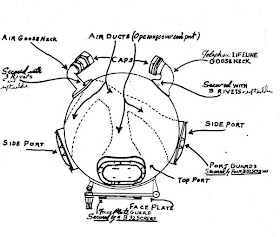"The U.S. Navy Mark V is the most coveted and recognized diving helmet in the world. It embodies helmeted diving with its bold look, functional design and long-standing history in American diving."
Stream-lining of the Mark Helmets
An earlier age of diving pioneers held the belief that the more extravagant and involved a diving apparatus, the more sophisticated it was, and therefore, the better it would be to convey a diver to depth. By the turn of the twentieth century, helmet manufacturers came to this realization that the more extravagant the design, the better chance something would fail, and there began a shift toward simplicity.
The U.S. Navy Mark V was created during the diving craze of the early twentieth century, when many different helmets were produced and knowledge about diving was becoming increasingly common. By 1917, G. L. Stillson completed the design of the Mark V, but at the time, no one could have foreseen the impact it would have on the history of diving.
This, of course, begs the question, what was different about this helmet that separated it from helmets of the same generation? Well, when Stillson called for the standardization of the Navy dive program, they needed not only good equipment, but it had to be the best. Main considerations were that it had to be easily fixable, comprehensible by the average enlisted-man, and sufficient for deep-dives. The combination of these requirements produced a well-built unit that would be used by the U.S. Navy for more than fifty years!
The design of the helmet, the placement of the components, and the size and weight considerations were completed by a process of trial and error. Four helmets were constructed and tried: the Marks I, II, III, and IV, and the best aspects from these four designs were used to build the Mark V helmet.
Early Mark Helmets: I-IV
Two companies manufactured the early Mark helmets. The Morse Company of Boston was first commissioned to build helmets to the navy standard. The identifying feature of the Morse helmets is the oval shaped side ports. The Shrader Company of New York was commissioned to build early Mark helmets as well but with their design instead, has circular side ports. Below are the Mark I-IV helmets made by Morse and Shrader:




The protagonist, the Mark V...
The Navy used the Marks I-IV, as shown above, with great success for many years, but with four designs in circulation, there still wasn't a standard helmet for the diving program (which was the original purpose of improving the diving program). Incorporating various design features of the earlier Mark helmets, allowed for the Mark V helmet to take on a common shape and features.
The Navy commissioned four companies to produce the Mark V diving helmets. They continued the already existing tradition with the Shrader and Morse Companies, but added the Diving Equipment and Supply Company (DESCO) of Milwaukee and the Miller-Dunn Company of Miami.
Morse Mark V
Mark V Expanded
The strategic placement of the components separated the Mark V from all other helmets. The Mark V remained the U.S. navy standard from 1915 to 1979 while it remained largely unchanged.
Front View

Side View
 Top View
Top View  Symbolism of the Mark V
Symbolism of the Mark VThe longevity of the helmet's application both militarily and commercially are are symbolic of the United States military at large. It stands as an identity of the ingenuity and design associated with the military similarly to the M16 rifle and the M113 tank.
If you ever get a chance to dive a Mark V you will understand why they are among the best ever made.







